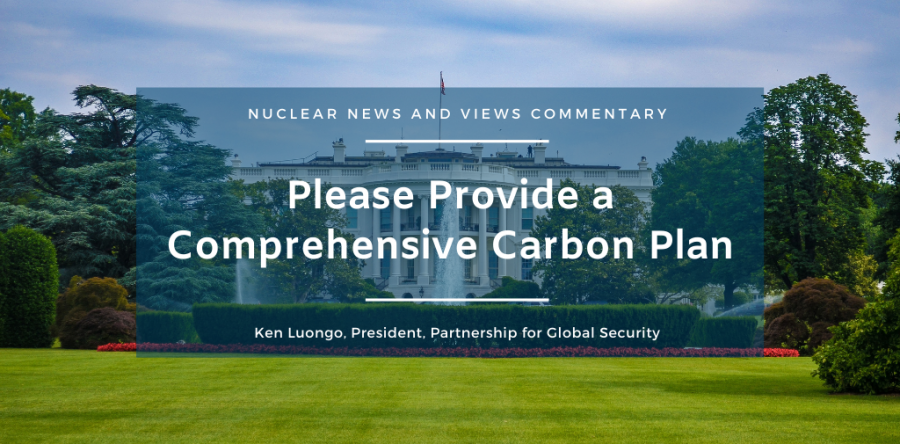Everyone understands that time is quickly closing in on the COP26 climate meeting in Glasgow in November, and that the U.S. needs to show leadership and bold carbon reduction commitments. But it desperately needs to demonstrate that it can realistically implement these promises.
The U.S. Department of Energy recently released a new blueprint to drive America from 3% to 45% reliance on solar power for electricity by 2050. This objective is admirable, ambitious, and popular. Its implementation will be very difficult.
And solar power is just one piece of the clean energy mosaic. There, unfortunately, is no similar comprehensive strategy for the vital but lesser loved technologies of carbon capture and next-generation nuclear power.
Carbon capture is necessary if natural gas remains a core fuel. Nuclear energy is currently responsible for over 50% of the country’s zero-carbon electricity emissions. But plants are aging and retirements looming before 2050.
There also are questions about the roadmap for the Biden administration’s March commitment to deploy 30 GW of offshore wind power by 2030, and the expansion of that share to 110 GW by 2050.
At the moment, the largest offshore wind farm is the U.K.’s Hornsea 1 project which has a capacity of about 1.2 GW. With planned additions it will expand by another 3 GW. How the U.S. will achieve almost eight times the total Hornsea project output in nine years is very unclear.
Similarly uncertain is how the administration will reach its goal that half of all cars sold by 2030 be electric vehicles to reduce transportation emissions. There are questions about whether the U.S. can install enough charging stations for these cars, a real concern because the top priority of potential EV purchasers is “range anxiety.”
An underplayed reality is that while all of the Biden administration’s carbon reduction plans are important and necessary, they will create unprecedented disruptions to the existing energy system at a time when the American population is divided and unsettled.
As a story on the solar power blueprint noted, “It would require a vast transformation in technology, the energy industry, and the way people live.”
In the U.S. the implementation of the clean energy evolution begins with the Congress providing the trillions of dollars that are required for the massive transformation. In the deeply divided nation that is now the United States, that funding is not guaranteed.
Also, the Congress is a provider of finance and oversight, not implementation. That weighty responsibility will fall on the executive branch. And it is not evident that all of America is prepared for a massive energy overhaul driven from Washington.
Public trust in the U.S. government is currently at 24%. And the inconsistency of the government’s response to the COVID-19 pandemic and the chaotic withdrawal from Afghanistan has further undermined confidence in the competence of officials and subject matter experts.
What’s true for the U.S. also is valid for many other industrialized nations. Politics, electricity prices, economic impact, power reliability, and institutional distrust are all serious concerns surrounding the clean energy transition.
Wind and solar are important parts of the clean energy policy of all industrialized nations, but turbines and panels generally have a lifespan of 25 years, necessitating additional investments and replacement. Much of that supply chain runs through China. And the intermittency and power storage limits of renewables are, at the moment, technological Achilles heels.
It is interesting to see a turn-around in the carbon reduction thinking of a highly industrialized nations like South Korea and Japan.
The current Korean president came to power in 2017 promising to decrease reliance on nuclear energy. But it provides over 50% of the nation’s zero-carbon electricity.
The Korean renewable energy plan is heavily focused on offshore wind power, but it is under political attack from fishing and other concerns. Its terrain is not well suited to solar power. So, facing reality, the government has pivoted to support small nuclear reactors as an element of its carbon reduction strategy.
Japan, deeply anti-nuclear after the Fukushima accident, also is embracing smaller, advanced nuclear power plants as a carbon reduction solution, in part because it faces similar challenges to South Korea.
The Glasgow COP is going to generate both glossy pronouncements about carbon reduction commitments and "code red" commands to solve the climate crisis. But this summit level rhetorical regurgitation has resulted in incremental progress at best on implementation. There needs to be a realistic carbon plan, not additional aspiration.
That means that while a comprehensive strategy for solar energy in the U.S. is very welcome, similar plans are needed for the other key elements of the carbon neutrality battleplan. At least in America, these need to be knitted into a comprehensive carbon strategy and implementation plan that doesn’t hide the ugly realities of the energy transition and ensures tangible progress. The pressure on clean energy commitments is mounting as global temperatures rise and the best way to respond to the heat is to perform not posture.
Ken Luongo, President, Partnership for Global Security


